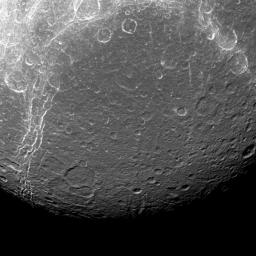
|
A Moon’s Contrasts
- Click the image above for a larger view
- Full-Res JPEG (1020 x 1020) (153.9 kB)
- Full-Res TIFF (1020 x 1020) (895.9 kB)
Caption:
Dione reveals its past via contrasts in this view from NASA's Cassini spacecraft. The features visible here are a mixture of tectonics -- the bright, linear features -- and impact cratering -- the round features, which are spread across the entire surface.
Tectonic features tell the story of how Dione (698 miles or 1,123 kilometers across) has been heated and cooled since its formation, and scientists use those clues to piece together the moon's past. Impact craters are evidence of external debris striking the surface, and thus they tell about the environment in which the moon has existed over its history.
This view looks toward the trailing hemisphere of Dione. North on Dione is up. The image was taken in visible light with the Cassini narrow-angle camera on April 11, 2015.
The view was obtained at a distance of approximately 68,000 miles (110,000 kilometers) from Dione and at a Sun-Dione-spacecraft, or phase, angle of 28 degrees. Image scale is 2,165 feet (660 meters) per pixel.
Background Info:
The Cassini mission is a cooperative project of NASA, ESA (the European Space Agency) and the Italian Space Agency. The Jet Propulsion Laboratory, a division of the California Institute of Technology in Pasadena, manages the mission for NASA's Science Mission Directorate, Washington. The Cassini orbiter and its two onboard cameras were designed, developed and assembled at JPL. The imaging operations center is based at the Space Science Institute in Boulder, Colorado.
For more information about the Cassini-Huygens mission visit http://saturn.jpl.nasa.gov and http://www.nasa.gov/cassini . The Cassini imaging team homepage is at http://ciclops.org .
Cataloging Keywords:
| Name | Value | Additional Values |
|---|---|---|
| Target | Dione | |
| System | Saturn | |
| Target Type | Satellite | |
| Mission | Cassini-Huygens | |
| Instrument Host | Cassini Orbiter | |
| Host Type | Orbiter | |
| Instrument | Imaging Science Subsystem (ISS) | |
| Detector | Narrow Angle Camera | |
| Extra Keywords | Crater, Grayscale, Impact, Visual | |
| Acquisition Date | ||
| Release Date | 2016-08-22 | |
| Date in Caption | 2015-04-11 | |
| Image Credit | NASA/JPL-Caltech/Space Science Institute | |
| Source | photojournal.jpl.nasa.gov/catalog/PIA20492 | |
| Identifier | PIA20492 | |
